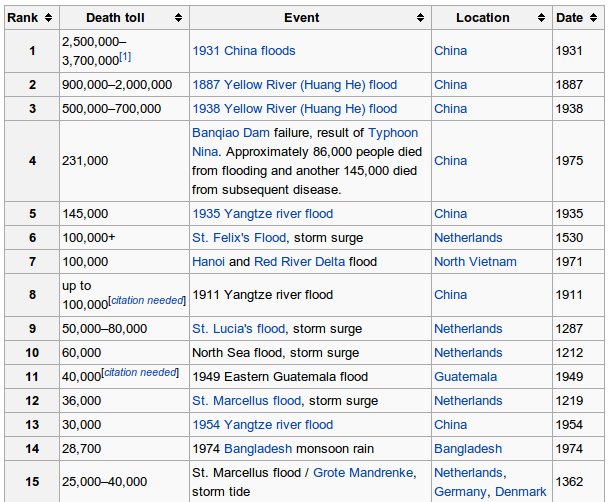Obama says that floods are getting worse due to global warming, but as is always the case, he has absolutely no clue what he is talking about. A storm surge in the year 1530 killed more than 1,000 times as many people as Sandy’s storm surge.
Disrupting the Borg is expensive and time consuming!
Google Search
-
Recent Posts
- New Visitech Features
- Ice-Free Arctic By 2014
- Debt-Free US Treasury Forecast
- Analyzing Big City Crime (Part 2)
- Analyzing Big City Crime
- UK Migration Caused By Global Warming
- Climate Attribution In Greece
- “Brown: ’50 days to save world'”
- The Catastrophic Influence of Bovine Methane Emissions on Extraterrestrial Climate Patterns
- Posting On X
- Seventeen Years Of Fun
- The Importance Of Good Tools
- Temperature Shifts At Blue Hill, MA
- CO2²
- Time Of Observation Bias
- Climate Scamming For Profit
- Climate Scamming For Profit
- Back To The Future
- “records going back to 1961”
- Analyzing Rainfall At Asheville
- Historical Weather Analysis With Visitech
- “American Summers Are Starting to Feel Like Winter”
- Joker And Midnight Toker
- Cheering Crowds
- Understanding Flood Mechanisms
Recent Comments
- Stuart Hamish on New Visitech Features
- Stuart Hamish on New Visitech Features
- Stuart Hamish on New Visitech Features
- Disillusioned on Ice-Free Arctic By 2014
- Disillusioned on Ice-Free Arctic By 2014
- Disillusioned on Ice-Free Arctic By 2014
- conrad ziefle on Ice-Free Arctic By 2014
- conrad ziefle on Ice-Free Arctic By 2014
- Jack the Insider on Ice-Free Arctic By 2014
- Bob G on Ice-Free Arctic By 2014



The St. Mary Magdalene’s flood (1342) at number 28 must have been very severe when you read about it. http://en.wikipedia.org/wiki/St._Mary_Magdalene%27s_flood
Just look up the cities how widespread this flood was. The other remarkable thing is that the flood was also very high and not beaten since.
Uh, do you suppose dikes built since the 1530 storm have something to do with less flooding? And what about the thousands of dams built in the last century?
I used to live in Bristol, and don’t remember seeing any dikes there.
If they can invent a scenario that CO2 can cause Global warming … they will invent dikes where there are none. The first casualty of a lie is the truth.
Steve,
Do you know the difference between tsunamis and big winter storms? Wasn’t about climate.
“…Written evidence from the time describes events that were similar to those that unfolded in the 2004 Indian Ocean earthquake and tsunami, including the sea receding before the wave arrived, a wave of water that rushed in faster than men could run, sparks coming off the top of the wave, and a crowd of people who stood and watched the wave coming towards them until it was too late to run. Some of the most detailed accounts also state that it had been a sunny morning.[8]…”
There are no subduction zones anywhere near the west coast of the UK. Not likely it was a Tsunami. More likely a storm surge which got amplified in the Bristol Channel, which has some of the highest tides in the world.
Doesn’t sound like a big storm, on a Sunny day, but I found this which doesn’t apply to AGW,
http://en.wikipedia.org/wiki/Meteotsunamis
and this about tsunamis in the Atlantic, and yes, I know that Bristol is on the other side “…The east coast of Scotland was struck by a 70 feet (21 m) high tsunami around 6100 BC, during the Mesolithic period. The wave was caused by the massive underwater Storegga slide off Norway, which occurred then….”
http://en.wikipedia.org/wiki/Tsunamis_affecting_the_British_Isles
Lots of action in Iceland.
There is nothing facing Bristol which could produce a tsunami. It is protected by Ireland, Wales and Cornwall. It most likely was a storm surge, possibly from a storm which passed a few tens of miles away.
Reblogged this on Climatism.